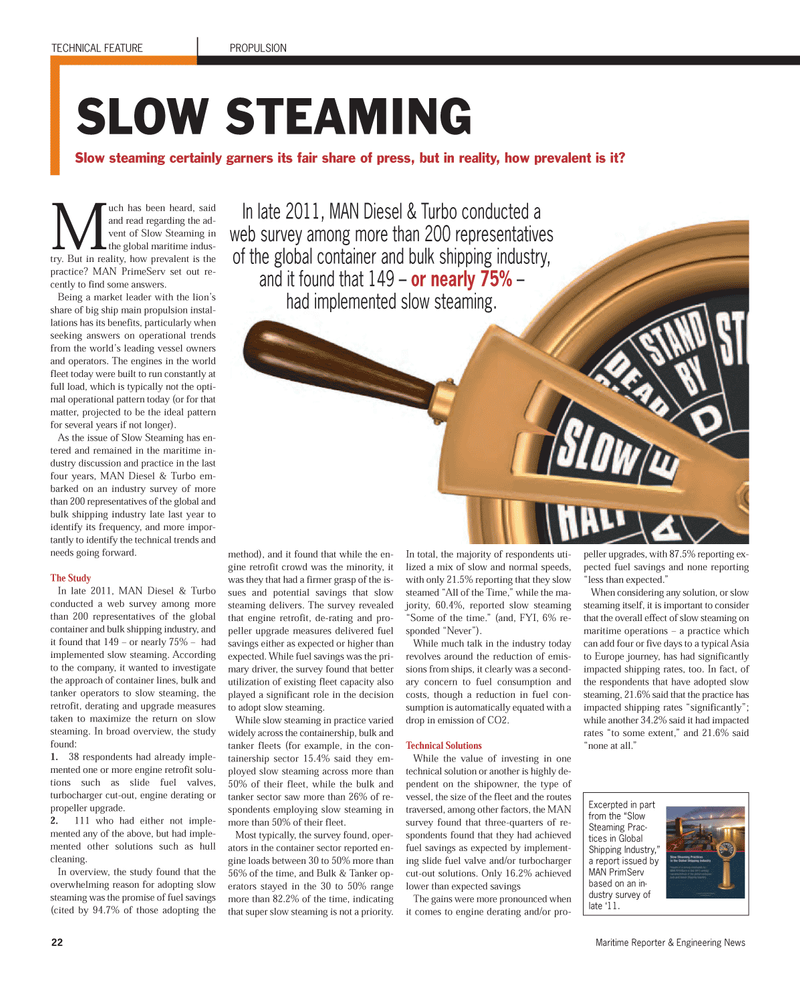
Page 22: of Maritime Reporter Magazine (July 2012)
Arctic Operations
Read this page in Pdf, Flash or Html5 edition of July 2012 Maritime Reporter Magazine
Much has been heard, saidand read regarding the ad- vent of Slow Steaming in the global maritime indus-try. But in reality, how prevalent is the practice? MAN PrimeServ set out re-cently to find some answers. Being a market leader with the lion?s share of big ship main propulsion instal-lations has its benefits, particularly when seeking answers on operational trendsfrom the world?s leading vessel owners and operators. The engines in the world fleet today were built to run constantly at full load, which is typically not the opti-mal operational pattern today (or for thatmatter, projected to be the ideal pattern for several years if not longer). As the issue of Slow Steaming has en- tered and remained in the maritime in-dustry discussion and practice in the lastfour years, MAN Diesel & Turbo em- barked on an industry survey of more than 200 representatives of the global and bulk shipping industry late last year to identify its frequency, and more impor- tantly to identify the technical trends andneeds going forward. The StudyIn late 2011, MAN Diesel & Turbo conducted a web survey among more than 200 representatives of the global container and bulk shipping industry, and it found that 149 ? or nearly 75% ? hadimplemented slow steaming. According to the company, it wanted to investigate the approach of container lines, bulk and tanker operators to slow steaming, the retrofit, derating and upgrade measures taken to maximize the return on slow steaming. In broad overview, the study found:1.38 respondents had already imple-mented one or more engine retrofit solu- tions such as slide fuel valves, turbocharger cut-out, engine derating or propeller upgrade.2.111 who had either not imple-mented any of the above, but had imple- mented other solutions such as hullcleaning.In overview, the study found that the overwhelming reason for adopting slow steaming was the promise of fuel savings (cited by 94.7% of those adopting themethod), and it found that while the en-gine retrofit crowd was the minority, it was they that had a firmer grasp of the is- sues and potential savings that slow steaming delivers. The survey revealed that engine retrofit, de-rating and pro- peller upgrade measures delivered fuel savings either as expected or higher than expected. While fuel savings was the pri- mary driver, the survey found that better utilization of existing fleet capacity also played a significant role in the decision to adopt slow steaming. While slow steaming in practice varied widely across the containership, bulk and tanker fleets (for example, in the con- tainership sector 15.4% said they em- ployed slow steaming across more than 50% of their fleet, while the bulk and tanker sector saw more than 26% of re- spondents employing slow steaming in more than 50% of their fleet. Most typically, the survey found, oper- ators in the container sector reported en-gine loads between 30 to 50% more than56% of the time, and Bulk & Tanker op- erators stayed in the 30 to 50% rangemore than 82.2% of the time, indicatingthat super slow steaming is not a priority. In total, the majority of respondents uti-lized a mix of slow and normal speeds, with only 21.5% reporting that they slow steamed ?All of the Time,? while the ma- jority, 60.4%, reported slow steaming ?Some of the time.? (and, FYI, 6% re- sponded ?Never?). While much talk in the industry todayrevolves around the reduction of emis- sions from ships, it clearly was a second- ary concern to fuel consumption andcosts, though a reduction in fuel con-sumption is automatically equated with adrop in emission of CO2.Technical Solutions While the value of investing in one technical solution or another is highly de-pendent on the shipowner, the type of vessel, the size of the fleet and the routes traversed, among other factors, the MAN survey found that three-quarters of re- spondents found that they had achieved fuel savings as expected by implement- ing slide fuel valve and/or turbocharger cut-out solutions. Only 16.2% achieved lower than expected savings The gains were more pronounced when it comes to engine derating and/or pro-peller upgrades, with 87.5% reporting ex- pected fuel savings and none reporting ?less than expected.? When considering any solution, or slow steaming itself, it is important to considerthat the overall effect of slow steaming on maritime operations ? a practice whichcan add four or five days to a typical Asia to Europe journey, has had significantly impacted shipping rates, too. In fact, of the respondents that have adopted slow steaming, 21.6% said that the practice hasimpacted shipping rates ?significantly?; while another 34.2% said it had impactedrates ?to some extent,? and 21.6% said ?none at all.? 22Maritime Reporter & Engineering News TECHNICAL FEATURE PROPULSIONSLOW STEAMINGSlow steaming certainly garners its fair share of press, but in reality, how prevalent is it? In late 2011, MAN Diesel & Turbo conducted a web survey among more than 200 representatives of the global container and bulk shipping industry, and it found that 149 ? or nearly 75%? had implemented slow steaming. Excerpted in part from the ?Slow Steaming Prac-tices in GlobalShipping Industry,? a report issued by MAN PrimServbased on an in-dustry survey oflate ?11.MR#7 (18-25):MR Template 7/9/2012 3:52 PM Page 22

 21
21

 23
23
